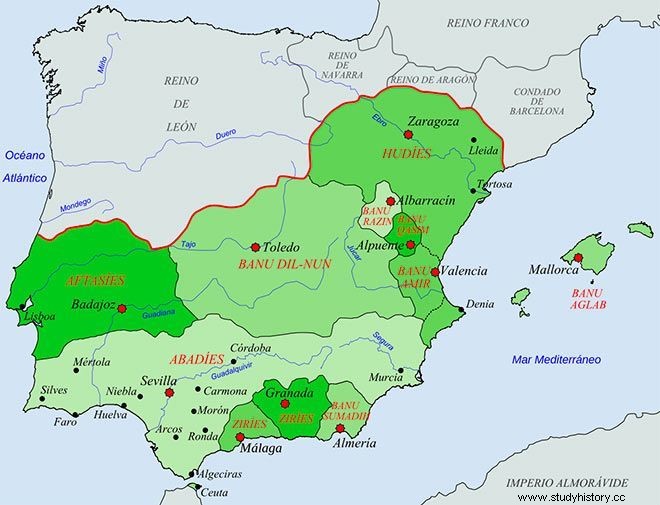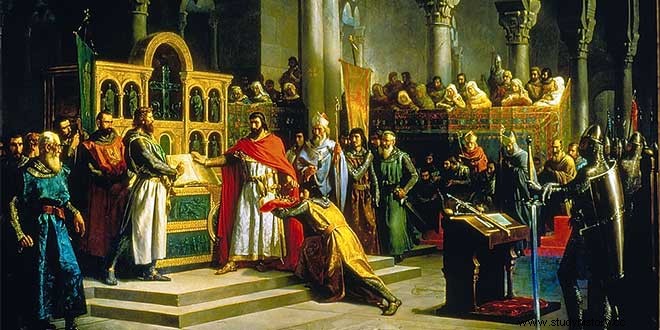On the death of Sancho III el Mayor de Pamplona , in the year 1035, his second son, Ferdinand , went on to govern the county of Castile, although adopting the royal title. Two years later, in 1037, the new Castilian monarch faced the king of León Bermudo III on the battlefield , of which he was his brother-in-law, since he was married to his sister, Sancha. Fernando I came out the winner of the fight, which took place in the vicinity of Tamarón. As a consequence of that event, Fernando I, known as the Great, proclaimed himself king of León. In this way, Castilla y León were once again united, but now with a royal title for both entities, while the name of Castilla preceded that of León. In the year 1054 the king of Castilla y León fought with his brother García Sánchez III of Pamplona, who was defeated and died in Atapuerca. In the final years of his reign, Fernando I (1035-1065) decided to take advantage of the weakness of the Taifas to launch, between 1055 and 1064, various military attacks against the territory of al-Andalus. The result of this offensive was the occupation of the important squares of Lamego, Viseo and Coimbra , all of them located in the area of what is now Portugal.

ConflictsbetweenChristiankingdoms
After the death of Fernando I (1065) there was a division of his kingdoms, placing his eldest son, Sancho II, at the head of Castile, while Alfonso VI went on to govern León, and García, Galicia. The three were awarded the outcasts of various Andalusian taifas:Zaragoza for the Castilian, Toledo for the Leonese and Seville and Badajoz for the Galician . The brothers soon came into conflict. Initially, Sancho II came out the winner, first in Llantada (1068), later in Golpejera (1072), success this last one that allowed him to gather in his hands the kingdoms over which his father had exercised sovereignty. Alfonso VI had to leave León, taking refuge in Toledo, that is, in the domains of his Muslim vassal. During that exile, in which he was accompanied by his vassal Pedro Ansúrez, Alfonso VI negotiated with the Taifa al-Qadir , preparing the ground that was to lead, years later, to his triumphal entry into Toledo. Meanwhile, the younger brother, García, had practically disappeared from the political scene. But the assassination of Sancho II at the hands of Bellido Dolfos on the outskirts of Zamora, a city controlled by his sister Urraca, which occurred in that same year of 1072, allowed Alfonso VI to return to the lands of the northern plateau, becoming King of Castile and Leon (1072-1109).
Did Alfonso VI have to take an oath in Santa Gadea that he had had nothing to do with the death of his brother Sancho? This affirms the tradition, according to which he had been the favorite vassal of Sancho II, Rodrigo Díaz de Vivar, better known as the Cid Campeador , who had demanded said oath before accessing the Castilian throne. This fact does not seem to have any historical foundation. Now, the fact is that Alfonso VI maintained difficult relations with the Cid , which ended up being exiled on several occasions from Castile. Apart from this controversy, Alfonso VI carried out actions of great importance for the kingdoms of Castile and León. Taking advantage of the weakness of the Pamplona kingdom, he incorporated into his kingdom, in the year 1076, various regions of La Rioja and the current Basque Country.

Conquest of Toledo
But the most important event of the reign of Alfonso VI was, without a doubt, the conquest of Toledo, an event that took place on May 25, 1085 . Apparently, the taifa kinglet of the city of the Tagus, al-Qadir, had previously agreed with the Castilian-Leonese monarch the delivery of that city, in exchange for being installed in the city of Valencia. After the entry of the Christian troops in the city that was the seat of the Councils of Visigothic times, and later the capital of the Middle Mark of al-Andalus, Alfonso VI adopted titles as pompous as imperator totius Hispaniae or emperor of the two religions . The Leon empire from past times it had become a Hispanic empire . Toledo, was the first great city of al-Andalus that passed to Christian power. The conquest of Toledo was completed with the occupation of a large part of the Tagus Valley, or what is the same, with the lands of that Taifa kingdom. The city of the Tagus received some settlers, among them ecclesiastics such as Bernardo, the first archbishop of the diocese as a result of the entry of Christians, soldiers and businessmen. But in Toledo the majority of its former population remained, in particular the Mozarabs and the Jews.
That success made it possible to resume the colonization process of the lands located between the Duero River and the Central System, the so-called extremadura . In order to attract settlers, criminals were even admitted. To the extremities came native settlers from the lands north of the Duero, but above all from the regions between the Cea river and La Rioja. Said territory was organized on the basis of the so-called communities of village and land or of towns and villages . Key strongholds were the cities of Segovia, Avila and Salamanca . The military nature of the aforementioned nuclei explains why they have been called border-cities . In these cities, the dominant sector was made up of the knights, who were going to launch, in the future, the famous cavalcades, which were expeditions over enemy lands whose main objective was the search for booty. Various cities and towns in the extremaduras they received privileges, highlighting, as the most significant, the one granted to Sepúlveda.
